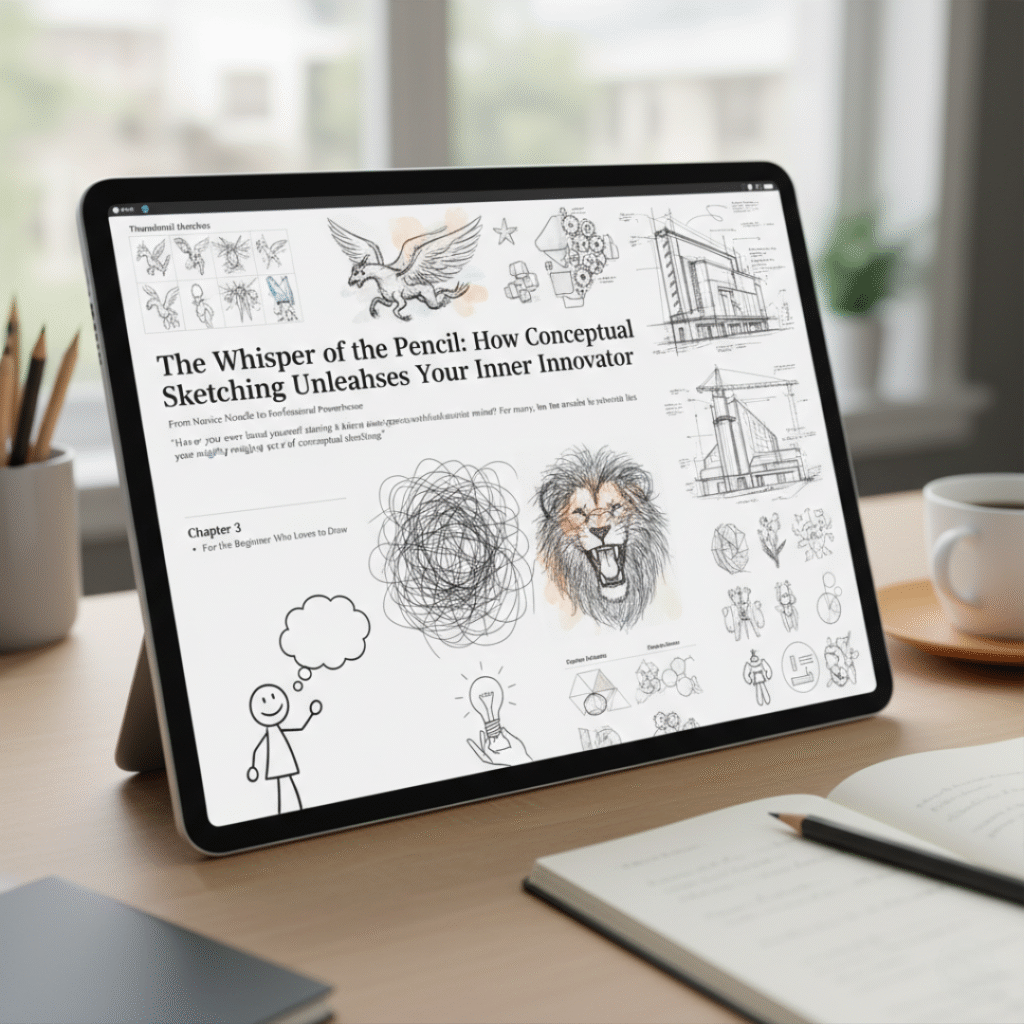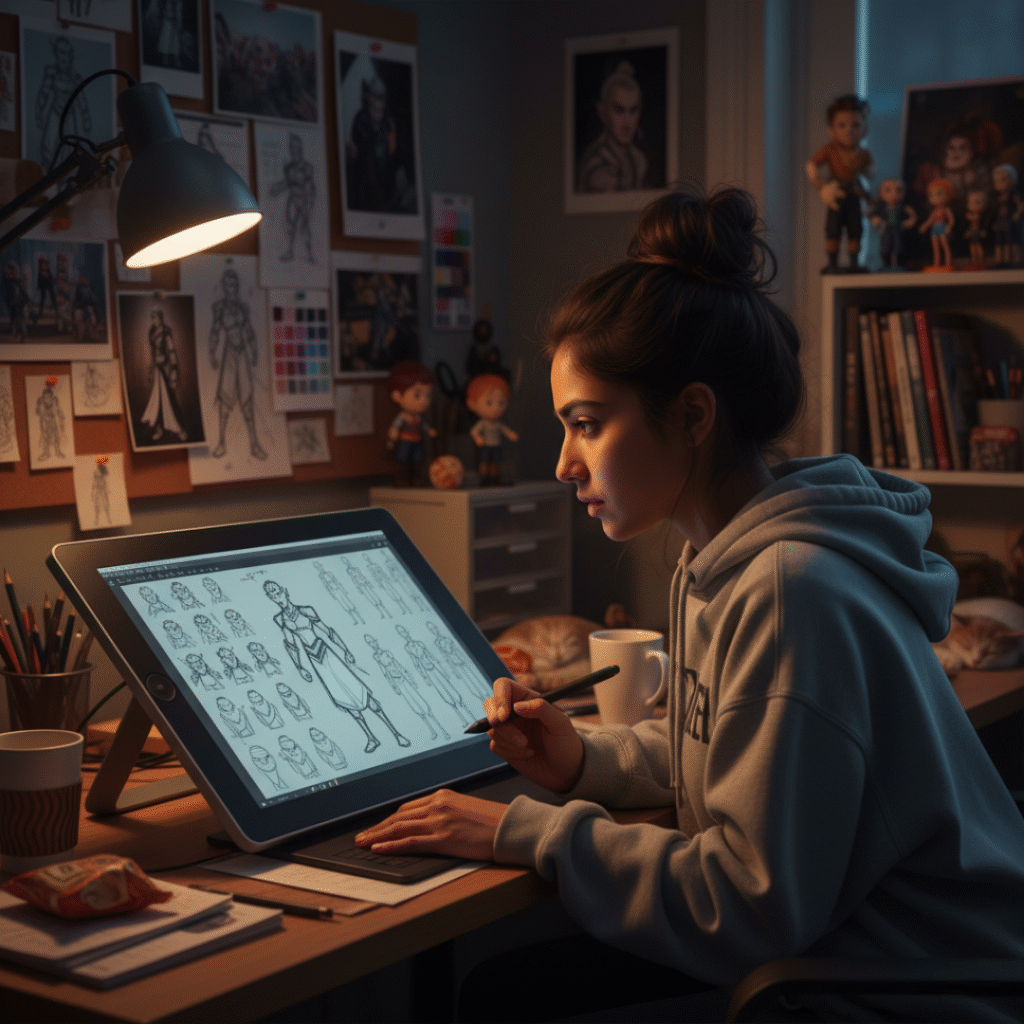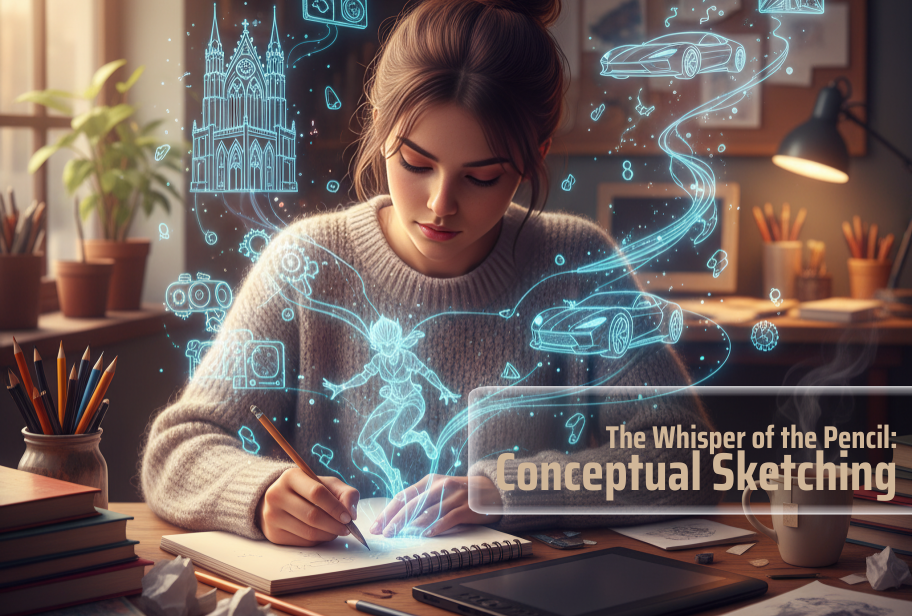Hey there, fellow creators! Have you ever found yourself staring at a blank page, a blank screen, or even just gazing out a window, a whirlwind of ideas swirling in your mind? Perhaps you have this fantastic notion for a new invention, a captivating character for a story, a revolutionary building design, or simply a beautiful scene you want to bring to life. But how do you capture that fleeting spark? How do you give shape to something that, for now, only exists in the ethereal realm of thought?
For many, the answer lies in the humble yet mighty act of conceptual sketching.
Forget everything you think you know about “perfect” drawings for a moment. Forget the pressure of creating a masterpiece that belongs in a gallery. Conceptual sketching is something entirely different. It’s the whisper of the pencil (or pen, or stylus) translating your internal monologue into a visual language. It’s the artist’s first conversation with an idea, a dialogue that shapes and refines before any final commitment is made.
Whether you’re someone who loves to doodle in the margins of your notebook, an aspiring artist eager to deepen your practice, or a seasoned professional whose work touches on design, engineering, or storytelling, understanding and embracing conceptual sketching can unlock a powerful new dimension in your creative process. Let’s embark on a journey, from the very basics to the profound impact of this incredible tool.
Chapter 1: The Seed of an Idea – What Exactly is Conceptual Sketching?
Imagine you’re a child, building a fort out of blankets and pillows. You don’t start by carefully measuring and cutting wood. No, you grab a blanket, drape it, see how it looks, adjust it, grab another, toss a pillow in, and voila! You’re intuitively “sketching” your fort, testing ideas, making quick decisions, and building as you go.
Conceptual sketching is very much like that, but with a drawing tool.
At its heart, conceptual sketching is the act of rapidly visualizing an idea. It’s about getting the core concept, the essence, down on paper as quickly as possible. The primary goal is not aesthetic beauty, but rather communication and exploration.
Think of it as:
- ➯ Visual Brainstorming: It’s your personal whiteboard for visual ideas.
- ➯ Problem-Solving Tool: A way to work through design challenges with lines and shapes.
- ➯ Rapid Prototyping: Testing out different visual solutions before investing significant time.
- ➯ The Blueprint of Imagination: The raw, unrefined first draft of your vision.
It’s often called “concept drawing” or “concept art” in various industries, and its value lies in its speed, its looseness, and its ability to turn the abstract into something tangible, however rough it may appear.
Chapter 2: Why Bother? The Hidden Powers of a Simple Sketch
You might be thinking, “But I’m not a ‘good’ artist. My sketches look messy.” And that’s precisely the point! The beauty of conceptual sketching lies in its imperfection. It liberates you from the tyranny of the “perfect line.” This freedom unleashes several hidden powers:
1. Ideas Take Shape Faster Than Words: Try describing a complex machine, a new character’s outfit, or the layout of an innovative garden using only words. It’s difficult, often clumsy, and open to misinterpretation. A few quick lines, however, can convey a surprising amount of information almost instantly. This speed allows you to cycle through many ideas in a short amount of time.
2. It’s a Visual Dialogue with Yourself (and Others): As you sketch, you’re constantly evaluating. “Does this angle work?” “What if I put this element here?” “Does this shape convey the feeling I want?” This ongoing dialogue helps you refine your thoughts. When sharing with others, a sketch bridges understanding gaps far more effectively than a verbal description. Everyone can point to the sketch and say, “I like this part,” or “What if we changed that aspect?”
3. Problem Solving on the Fly: Design is often about solving problems. How does light hit this object? Where does the door go in this space? How does this character move? By sketching, you can visually test solutions to these problems. You might draw ten versions of a character’s arm until you find the one that feels right for their personality and movement. It’s an iterative process of trial and error, all done quickly and without commitment.
4. Unleashing Creativity and Overcoming Fear: The pressure to create a “finished” piece can paralyze creativity. Conceptual sketching removes that pressure. Because it’s meant to be rough and exploratory, you’re free to experiment wildly, make “mistakes” (which are just learning opportunities!), and let your imagination run rampant without judgment. This liberation is incredibly empowering, especially for beginners who might be intimidated by drawing.
5. Building a Visual Library: The more you sketch, the more you train your eye and your hand. You start to understand forms, perspectives, light, and shadow more intuitively. Even if a particular sketch never becomes a final piece, the act of creating it strengthens your visual vocabulary and improves your overall drawing skills. It’s practice, disguised as exploration.
Chapter 3: From Novice Noodle to Professional Powerhouse – How Everyone Benefits
Conceptual sketching isn’t just for a specific type of artist or profession. Its universality is one of its greatest strengths.
For the Beginner Who Loves to Draw (or Wants To):
You don’t need fancy tools or years of training to start. All you need is a pencil and paper (or a digital equivalent).
- ➯ Start with “Thumbnail Sketches”: These are tiny, quick sketches, often no larger than a postage stamp. Their small size forces you to focus only on the biggest shapes and the overall composition. Don’t worry about details at all. Try drawing 10-20 thumbnail ideas for a single concept in just a few minutes.
- ➯ Focus on the “Big Picture”: Think about the main forms, the direction of light, the general feeling. Don’t worry about perfect lines or shading.
- ➯ Embrace the Mess: Your first sketches will be rough, and that’s exactly how they should be. The more comfortable you get with “messy,” the more ideas you’ll generate.
- ➯ Draw from Life and Imagination: Sketch objects around you quickly. Then try to sketch things purely from your mind. The combination builds both observation skills and imaginative muscles.
Let’s say you want to draw a fantastical creature. Don’t start trying to draw the perfect scales. Instead, sketch ten different head shapes, then ten different body shapes, then different wing ideas. See how they combine!

For Professionals (Designers, Architects, Engineers, Illustrators, Writers):
For those already working in creative or technical fields, conceptual sketching isn’t just a hobby; it’s an indispensable professional tool.
➯ Architects and Industrial Designers: Before CAD software, there was the sketch. Architects use conceptual sketches to quickly explore building masses, interior layouts, and aesthetic forms. Industrial designers sketch dozens of product iterations, exploring ergonomics, aesthetics, and functionality before any detailed rendering begins. A quick sketch can save hours, days, or even weeks of detailed digital work if an idea isn’t viable.

- ➯ Illustrators and Animators: Character designers will sketch hundreds of expressions, poses, and outfit variations to nail down a character’s personality. Storyboard artists use quick conceptual sketches to plan out camera angles, character blocking, and scene flow for films and animations. These aren’t polished drawings; they’re functional tools to visualize narrative.
- ➯ Game Developers: From level design to character concepts and user interface ideas, game developers lean heavily on conceptual sketching to map out their virtual worlds and experiences.
➯ Writers and Storytellers: Even if you don’t draw well, a quick sketch of a character, a setting, or a key scene can deepen your understanding and help you craft more vivid descriptions. It’s a visual aid for your narrative imagination.

Conceptual sketching provides a common visual language, streamlining communication within teams and with clients. It’s about quickly laying down ideas to get feedback, iterate, and move forward efficiently.
Chapter 4: Your Toolkit for Conceptual Exploration
You don’t need much to start, and that’s part of its appeal!
- ➯ The Essentials:
- ➧ Paper: Any kind! Printer paper, a cheap sketchbook, even a napkin. The less precious the paper, the more freedom you’ll feel.
- ➧ Pencil/Pen: A simple Bic pen or a mechanical pencil is perfect. Don’t overthink it. The goal is flow, not fancy materials.
- ➯ Stepping Up (Optional):
- ➧ Sketchbook: A dedicated sketchbook can help organize your thoughts and track your progress. Look for one with decent paper that can handle a bit of ink or marker if you like.
- ➧ Different Pencils/Pens: Experiment with different lead hardness (HB, 2B, 4B) for pencils to get darker lines, or various pens (fineliner, ballpoint, brush pen) to see what feels good.
- ➧ Markers (Grey Tones): A few grey markers (light, medium, dark) can quickly add a sense of form and depth to your sketches, helping to define volumes without getting caught up in color.
- ➧ Digital Tablet: Tools like an iPad with Procreate, a Wacom tablet with Photoshop, or Clip Studio Paint offer endless possibilities for layers, undo, and quick adjustments, making digital conceptual sketching incredibly powerful.
Remember, the tool is secondary to the act. The most important thing is to start sketching.
Chapter 5: Making It a Habit – Embrace the Journey, Not Just the Destination
Like any skill, conceptual sketching gets better with practice. Here are a few tips to make it a regular and enjoyable part of your creative life:
- ➯ Carry a Sketchbook: You never know when inspiration will strike. A small sketchbook and pen in your bag mean you’re always ready to capture ideas.
- ➯ Set Small Goals: Don’t aim to draw a masterpiece every day. Aim to fill a page with 10 tiny thumbnail sketches, or draw 5 variations of a simple object. Consistency trumps intensity.
- ➯ Draw Everything: Sketch mundane objects, people on the bus, scenes from movies, your hand, a crumpled piece of paper. The more you draw, the better your visual library becomes.
- ➯ Don’t Erase (Too Much): Especially in the initial stages, try to draw over your lines or accept the “mistakes.” This keeps your flow going and helps you build confidence. When you get stuck, try drawing the same thing from a different angle or with a different style.
- ➯ Look for Inspiration: Browse art books, Pinterest, Instagram, Dribbble. Pay attention to how others break down complex ideas into simple forms. But then, put the reference away and try to sketch from memory or your own interpretation.
- ➯ Critique with Kindness: Look at your sketches not as “good” or “bad,” but as “effective” or “ineffective” in communicating your idea. What worked? What could be clearer?
A Modern Tool for an Age-Old Technique: GridSketcher
As we’ve explored, the grid method is a powerful tool for artists of all levels. It helps break down complex images into manageable sections, making it easier to nail proportions and detail. While this method has been used for centuries with just a ruler and a pencil, modern technology has made it even more accessible.
This is where a tool like GridSketcher comes in.
GridSketcher is a fantastic application that combines the power of the classic grid method with the convenience of a digital tool. It allows you to transform any photo into a sketch or outline and then overlay a customizable grid on top.
How does it help a conceptual sketcher?
- ➯ Precision without the Guesswork: If you have a specific reference image you want to use as a starting point for your conceptual sketch-say, a photo of a car you want to redesign, or a face you want to use as the base for a fantasy character-GridSketcher can help you get the foundational proportions right. You can adjust the number of rows and columns to match the level of detail you need, and even tweak the intensity of the sketch overlay.
- ➯ A Digital Lightbox: The app lets you zoom, pan, and toggle between the original image and the sketch, acting like a digital lightbox that helps you see the core lines and shapes more clearly. This is a great way to study how form and structure are created in a reference photo, which you can then apply to your own imaginative drawings.
- ➯ A Learning Aid: For beginners who feel intimidated by drawing from scratch, using a tool like GridSketcher is a great way to build confidence. It helps you train your eye to see relationships between shapes and to understand how to transfer what you see onto paper. It’s not a crutch, but a valuable training tool that can quickly improve your observational skills, which are crucial for any artist.
Ultimately, whether you use a simple pencil and paper or a sophisticated app like GridSketcher, the goal remains the same: to get your ideas flowing. Technology simply provides new and exciting ways to support that creative process.
The Final Stroke: Your Idea, Unbound
Conceptual sketching is more than just drawing; it’s a mindset. It’s about being curious, iterative, and unafraid to explore. It’s about understanding that the journey of an idea, from its first whisper to its final form, is a process of discovery.
So, the next time an idea sparks in your mind, don’t let it fade. Grab a pencil, find a piece of paper, and let your hand do the thinking. Allow those first, tentative lines to emerge. Watch as your abstract thoughts gain form, texture, and possibility. You’re not just drawing; you’re innovating. You’re giving life to something new.
Go forth and sketch, fellow creators. Your brilliant ideas are waiting to be unleashed, one whisper of the pencil at a time.


